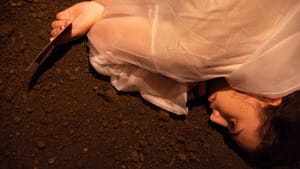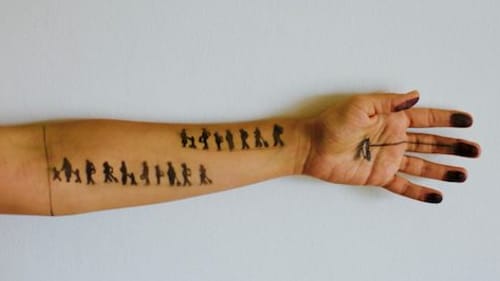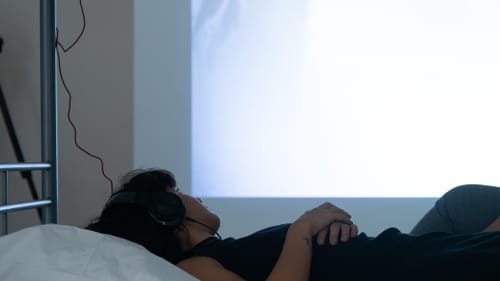Stay in the Loop
BSR publishes on a weekly schedule, with an email newsletter every Wednesday and Thursday morning. There’s no paywall, and subscribing is always free.
On the border
Philly Fringe 2018: 'ear-whispered': Works by Tania El Khoury

Five works by Lebanese live artist Tania El Khoury, collectively titled ear-whispered, are presented with Bryn Mawr College as a part of the 2018 Curated Fringe Festival. The works demand — and largely earn — extraordinary emotional, imaginative, and even corporeal engagement from spectators.
Thematically linked, but aesthetically autonomous, each piece deals with an aspect of the ongoing Middle East refugee crisis. They cut against the numbing onslaught of statistics by operating on a relentlessly intimate scale.
Gardens Speak
The most powerful of these pieces is Gardens Speak, a performance with no performers for 10 audience members. In Syria, the bodies of many freedom fighters are buried in gardens to avoid holding funerals in public, where they would likely become targets for the oppressive Assad regime.
Here, El Khoury recreates one of these makeshift cemeteries. The stage for the piece is a raised bed of soil marked with tombstones written in Arabic. We are invited to kneel at one of the tombstones and dig until we find a speaker marked with a name on the tombstone in English. Then we lie down in the dirt with our ears pressed to the ground, listening to a low voice recount, in the first person, the story of how they lived and died.
I heard Basil Shehadeh, a young Christian filmmaker and anti-Assad activist killed by government forces in Homs. I learned about his life, loves, aspirations, and the pomegranate-flower petals his friends scattered on his coffin before he was buried. Listening to “Basil’s” kind, resigned voice while recumbent, breathing in the scent of the cool, damp soil, embracing his memory, embracing the grave, I was overwhelmed with grief for this man I never knew.
As Far as My Fingertips Take Me
Specificity and tangible immediacy are also strengths of As Far as My Fingertips Take Me, an intense, 12-minute performance for an audience of one. Wearing headphones, I followed instructions, putting my hand through a hole in a wall, feeling the fingertips of a stranger touch mine.
Basel Zaraa, a Syrian refugee, told me the story of his family’s journey to seek asylum in Sweden. Meanwhile, he tenderly supported and guided my hand as he marked it with ink. When his story ended, I withdrew my arm and found it adorned with tiny figures bearing luggage, all traveling in the same direction; a great migration in miniature, inscribed on my flesh by one who had lived to tell the tale.
When Zaraa emerged from behind the wall to greet me, it felt like a miracle that fate had contrived to bring the two of us together to share this encounter despite the many obstacles he confronted along the way. The world suddenly seemed a very small, friendly, and even understandable place.

Compared to these pieces, El Khoury’s two video installations, Stories of Refuge and Camp Pause, pack less of a punch.
Stories of Refuge
Stories of Refuge introduces spectators to three Syrian refugees living in collective housing projects in Munich. Gesturing toward the institutional sterility of their provisional accommodations, El Khoury furnishes a gallery with metal bunk beds. She invites spectators to lie down, put on headphones, and watch videos shot and narrated by these recently arrived, anonymous asylum seekers.
The asylees describe overflowing shared toilets as the camera pans dreary, crowded rooms. A wilting bouquet of flowers and other occasional small personal touches only reinforce the overwhelming hostility of the architecture; these spaces were never intended to serve as long-term homes. Yet these three Syrians and hundreds of thousands more have risked their lives and endured truly infernal conditions to get here. Their accounts of life under the Assad regime and of being smuggled into Germany by land and by sea are indeed harrowing.
In Gardens Speak, every aspect of what we hear, see, feel, smell is carefully calibrated to awaken our empathy and righteous rage. But in Stories of Refuge, the installation’s “immersive” dimension feels like an afterthought.
Camp Pause
The same holds true for Camp Pause, which El Khoury made with the Beirut-based Dictaphone Group. Four videos play on the four walls of a gallery, each following a resident of the Rashidieh Refugee Camp for Palestinians on the coast of Lebanon. Spectators sit on stools in the center of the space and put on headphones to listen to each of the subjects describe life in the camp, focusing on his or her relationship to the sea.

A little girl complains that the beach is polluted because people throw their trash wherever they please. A fisherman speculates that his haul has gotten lighter in recent years because of all the sewage people dump into the sea. An old woman blames the proximity of the sea for a litany of ailments, including diabetes. An amputee stares out at the gently breaking waves, momentarily at peace. Children run through the streets of the camp in high spirits, celebrating the end of Ramadan and chasing each other with toy guns.
It is a place of many fascinating and disturbing contradictions. But once again, the design of the Camp Pause installation does little to make the struggles of its subjects feel less remote than they would in an ordinary documentary film.
Overall, ear-whispered remains a remarkable survey of a remarkable artist’s work. El Khoury addresses some of the most pressing and seemingly intractable issues facing our world, and her work recalls audiences to the critical awareness of these problems as our collective responsibility.
Tell Me What I Can Do
At the end of Gardens Speak, we are invited to write a letter to the dead person whose story we heard and bury it in the soil at the foot of the “grave.” These letters, collected from the 28 cities around the world where Gardens Speak has toured, supply the content of Tell Me What I Can Do, making its world premiere here as the fifth and final work of ear-whispered.
Hundreds of letters in many languages testify to the impact of the piece. “Your loss is inexcusable,” mine will read when added to this living archive. “I am ashamed of the world for allowing it to come to pass.”
What, When, Where
ear-whispered: Works by Tania El Khoury. Through September 23, 2018. (214) 413-1318 or fringearts.com.
Gardens Speak. Bryn Mawr College's Hepburn Teaching Theater in Goodhart Hall, 150 N. Merion Avenue, Bryn Mawr, Pennsylvania.
Camp Pause. Bryn Mawr College's Canaday Library Rare Book Room, 101 N. Merion Avenue, Bryn Mawr, Pennsylvania.
As Far as My Fingertips Take Me. Bryn Mawr College's Taft Garden, Bryn Mawr, Pennsylvania.
Stories of Refuge. Twelve Gates Arts, 106 N. Second Street, Philadelphia.
Tell Me What I Can Do. Bryn Mawr College's Goodhart Hall Common Room, 150 N. Merion Avenue, Bryn Mawr, Pennsylvania.
Sign up for our newsletter
All of the week's new articles, all in one place. Sign up for the free weekly BSR newsletters, and don't miss a conversation.

 Jessica Rizzo
Jessica Rizzo